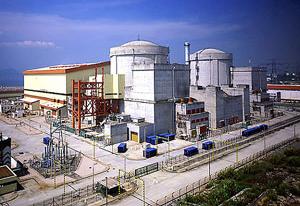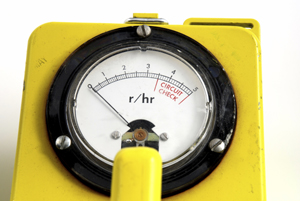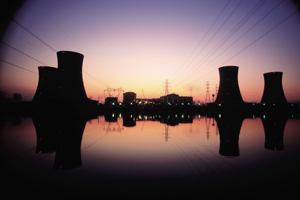Nuclear Renaissance headed for a Thirty Years' War?
on
Nuclear Renaissance headed for a Thirty Years' War?
The nuclear renaissance has always been more a promise than a reality, certainly in the OECD countries, where expansion of capacity remains an illusion. The tragedy in Japan will probably cause further delays, leaving other power production technologies to fill the future gap in demand, predicts energy editor Chris Cragg. Nuclear energy might become like the old soldier that does not die, but simply fades away.
 |
| Guangdong Daya Bay was the first commercial nuclear power station in China (Photo: CLP Group) |
Given that the plant was a Framatome design and that Daya Bay was in an earthquake zone, they were naturally concerned. Fearing that this was a mistake in reading the plans, the French took the problem to their Chinese colleagues. They were then candidly informed that: first they did not understand the urgency with which China needed the power, secondly they did not understand the need for economy, thirdly that nobody would ever know, except in the event of a catastrophe in which case it would be too late anyway, and finally what did they think they were going to do about it because the concrete was set solid?
The story may have been a joke against the Chinese and French. It was certainly unverifiable, even at the time. It did however get a lot of currency, perhaps because it illustrated so many of the aspects of the debate about nuclear power. First and foremost it illustrated the perceived need. China, with a then per capita electricity consumption of 813 kWh (about one tenth of that in, for example, Taiwan) was in a hurry and has continued to be so. Secondly, people within the nuclear industry and many outside it are acutely aware of its extremely high capital costs compared with conventional plant and, equally, the huge tail of the financial liabilities of nuclear waste that it drags around behind it; a problem that nobody has yet satisfactorily managed to solve.
The third idea, that people would never find out failings short of catastrophe, is not universally true, but there is something unique about the industry in its "low-risk versus highly dangerous outcome"
| There is something unique about the industry in its "low-risk versus highly dangerous outcome" configuration |
Misunderstood
Nuclear power plants are very complex machines. The temptations to take shortcuts from what is written in the manual or delay replacing parts are obvious, particularly under pressure of time and the need for production. Inspection for faults requires both enormous knowledge and attention to detail. Back in 2004, a pipe in the Kansai Electric Mihama-3 unit in Japan burst and killed five people with superheated steam. It had eroded from 10 mm to 1.4 mm thickness in 27 years of operation, but had been overlooked. It should have been replaced but there was no visible sign that it was under pressure and the accident illustrates the nature of the problem.
At the same time, radiation is particularly misunderstood by the general public, aided by a sensationalist press. The tragedy at Fukushima has drawn inevitable comparisons with the bombing of Hiroshima and Nagasaki as if the deliberate bombing of the two cities was the same thing as the desperate attempt to reduce radiation from a major accident. Equally the internet has been quick to distribute unverifiable stories about Tokyo Electric Power Company's incompetence. While it is true that TEPCO does not have an entirely clean track record for honesty, the idea that it brought in 55 small locally provided generator-sets but could not use them because they all had different connections, could, if true, be a sign of desperation rather than incompetence.
The facts so far are these: Fukushima was hit by one Japan's worst ever earthquakes, shortly followed thereafter by one of the worst tsunamis. It suffered major loss of coolant incidents in three reactors virtually simultaneously and subsequently a fire in the cooling pond of another one. There are a lot of
| Seismic zone? No! Tick! Tsunami likely? No! Tick! |
Of course, if the Chinese story is true, there was nothing much the French engineers could do about it. It was indeed set in concrete and so is the current issue. As of now there are 437 nuclear reactors worldwide and a further 58 or so supposedly under construction, some of them certainly more worrying in both design and operation than those at Fukushima before the earthquake. They produce around 14% of global electricity and amount to 360 GW. Much as the anti-nuclear perceptions would like them to be shut down or cease to exist, they would still leave a heavy legacy of radioactive waste, without any compensating income to deal with it. Their shutdown would also demand a huge increase in renewable energy, if there was not to be a huge expansion in global CO2 output.
Price impact
Following the disaster at Fukushima, there has been a predictable response from politicians. Angela Merkel in Germany has ordered the shutdown of seven older reactors, built before 1980, for three months, out of a grand total of 17. Given that the seven produce about 5% of Germany’s electricity, the immediate impact may well be an expansion of output from the rest, or alternatively an increase in coal consumption. An unexpected casualty may be the €2.3 billion annual tax paid by the nuclear industry on new fuel rods for the development of renewable technology. The shutdown has had an immediate upward price impact on the energy futures market exchanges and Germany's industrial leaders have rapidly expressed concern about their competitiveness due to high energy costs.
 |
| Radiation is particularly misunderstood by the general public, aided by a sensationalist press |
Meanwhile Huhne has been telling people not to "rush to judgement" about nuclear power. Given that successive British Governments have lamentably failed to address the coming shortfall in UK power capacity for a decade, they can certainly not be accused of "rushing to judgement" about anything. With all but one of Britain's nuclear units due to be shut by 2023, this might be an opportunity to announce that the UK could go nuclear free, but the shift would require a degree of government intervention and money that is certainly beyond even the current, highly radical, coalition Government. A 10 GW tidal power system on the Severn River has been ruled out anyway.
Meanwhile the Austrians have called for all Europe's nuclear reactors to be pressure tested, which is sensible, but does not require action in Austria itself, since Austria is a nuclear free zone. Ever since the fiasco of the Zwentendorf reactor, which was built at high cost in the late 1970s, but never run, the Austrians have been radically anti-nuclear in spite of the fact that the International Atomic Energy Agency (IAEA) headquarters provides significant amounts of money to the local Viennese economy. In addition, being heavily import dependent, Austria has some difficulty deciding which parts of the incoming kWh are nuclear generated.
Still, their anti-nuclear stance does give them a stick to beat the Swiss with, since Switzerland has around 39% of its electricity capacity in nuclear units, although they now are arguing about extensions. The French have not commented, which is hardly surprising given that 75% of their power capacity is nuclear. Nor have the Swedes (37%), nor the Finns (33%) nor the Hungarians (43%), nor the South Koreans (31%). As the old joke has it, if you wanted to go to a nuclear-free world you would not start from here.
Under construction
And the US? With 104 functioning nuclear plant or about 20% of capacity, the US has been a perceived springboard for the so-called nuclear renaissance. In February 2010, two reactors at Georgia Power’s
| The battle to build more nuclear plant will become even more long-winded and confrontational than it already is |
This shows clearly the dilemma associated with the nuclear industry. It has always acted on the assumption that it would replicate itself. There has never been a "Plan B", based on the idea that new construction would stop. Few things illustrate this better than the problem of waste, but it is also shown in the fact that the economies of scale, made by building big 1,000 MW units in series, means that finding a replacement source of electricity is extremely expensive with a knock-on impact on fossil fuel prices. The industry has always assumed that the solution to this is to build new nuclear units alongside the old ones, but as controversy about safety has risen and the time taken to build replacement nuclear capacity has lengthened, the temptation to extend the life of existing plant becomes ever greater. Globally, for all the talk of a nuclear renaissance, the industry is not remotely near replacing itself in the west.
Back in 2010, a group sponsored by the British Royal Institute of International Affairs (RIIA), produced a report entitled "International Perspectives on Energy Policy and the Role of Nuclear Power". Between them, Lutz Metz, Mycle Scheider and Steve Thomas looked in detail at all the projections for new construction in the industry. As of January 2009, the IAEA listed 44 plant as under-construction, or ten more than in 2007. However, not only was this ten fewer than in January 1999, but of those 44 listed, 11 had been listed as "under construction" for the past 20 years and 20 of them had no official start up date.
Meanwhile the US Department of Energy issued a command in 2001 "to complete and construct and deploy multiple commercially viable new nuclear plants by 2010". Ten years on, nothing has been built, so that over 50% of US nuclear stock is over 30 years old. In Europe the figure is 20% and rising.
| The disaster has made the decision to commit to building new capacity even more difficult than it already is. |
Inertia
The events at Fukushima cannot but increase political inertia about building more nuclear power in both Western Europe and the US. While this does not mean that nuclear capacity will be shut down before its time, or that building new reactors will be off the agenda completely, such delays are not politically neutral. The disaster has made the decision to commit to building new capacity even more difficult than it already is. Take the UK as one example. Given that nuclear construction times can be almost as long as a decade, if the Government waits much longer to make a decision, such will be the pressure on capacity that it will be forced to sanction the building of rapidly erected gas-fired plant simply to keep the lights on.
 |
| The events at Fukushima cannot but increase political inertia about building more nuclear power in both Western Europe and the US |


Discussion (0 comments)